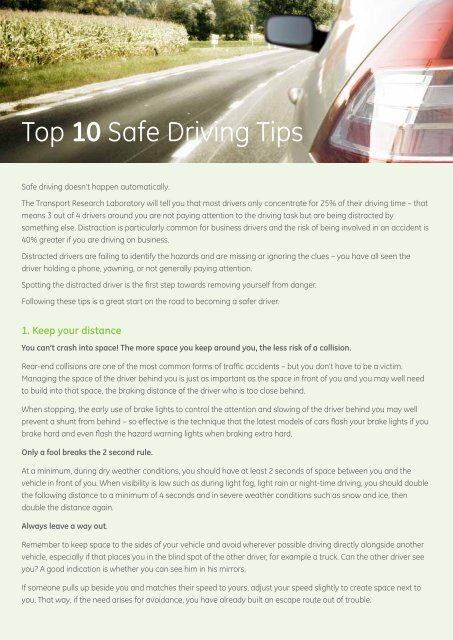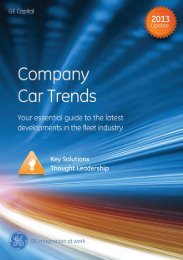Top 10 Safe Driving Tips - GE Capital UK
Top 10 Safe Driving Tips - GE Capital UK
Top 10 Safe Driving Tips - GE Capital UK
Create successful ePaper yourself
Turn your PDF publications into a flip-book with our unique Google optimized e-Paper software.
<strong>Top</strong> <strong>10</strong> <strong>Safe</strong> <strong>Driving</strong> <strong>Tips</strong><br />
<strong>Safe</strong> driving doesn’t happen automatically.<br />
The Transport Research Laboratory will tell you that most drivers only concentrate for 25% of their driving time – that<br />
means 3 out of 4 drivers around you are not paying attention to the driving task but are being distracted by<br />
something else. Distraction is particularly common for business drivers and the risk of being involved in an accident is<br />
40% greater if you are driving on business.<br />
Distracted drivers are failing to identify the hazards and are missing or ignoring the clues – you have all seen the<br />
driver holding a phone, yawning, or not generally paying attention.<br />
Spotting the distracted driver is the first step towards removing yourself from danger.<br />
Following these tips is a great start on the road to becoming a safer driver.<br />
1. Keep your distance<br />
You can’t crash into space! The more space you keep around you, the less risk of a collision.<br />
Rear-end collisions are one of the most common forms of traffic accidents – but you don’t have to be a victim.<br />
Managing the space of the driver behind you is just as important as the space in front of you and you may well need<br />
to build into that space, the braking distance of the driver who is too close behind.<br />
When stopping, the early use of brake lights to control the attention and slowing of the driver behind you may well<br />
prevent a shunt from behind – so effective is the technique that the latest models of cars flash your brake lights if you<br />
brake hard and even flash the hazard warning lights when braking extra hard.<br />
Only a fool breaks the 2 second rule.<br />
At a minimum, during dry weather conditions, you should have at least 2 seconds of space between you and the<br />
vehicle in front of you. When visibility is low such as during light fog, light rain or night-time driving, you should double<br />
the following distance to a minimum of 4 seconds and in severe weather conditions such as snow and ice, then<br />
double the distance again.<br />
Always leave a way out.<br />
Remember to keep space to the sides of your vehicle and avoid wherever possible driving directly alongside another<br />
vehicle, especially if that places you in the blind spot of the other driver, for example a truck. Can the other driver see<br />
you? A good indication is whether you can see him in his mirrors.<br />
If someone pulls up beside you and matches their speed to yours, adjust your speed slightly to create space next to<br />
you. That way, if the need arises for avoidance, you have already built an escape route out of trouble.








